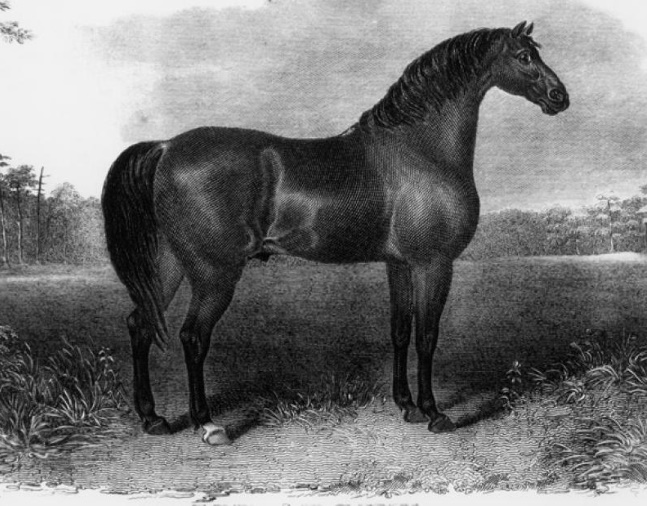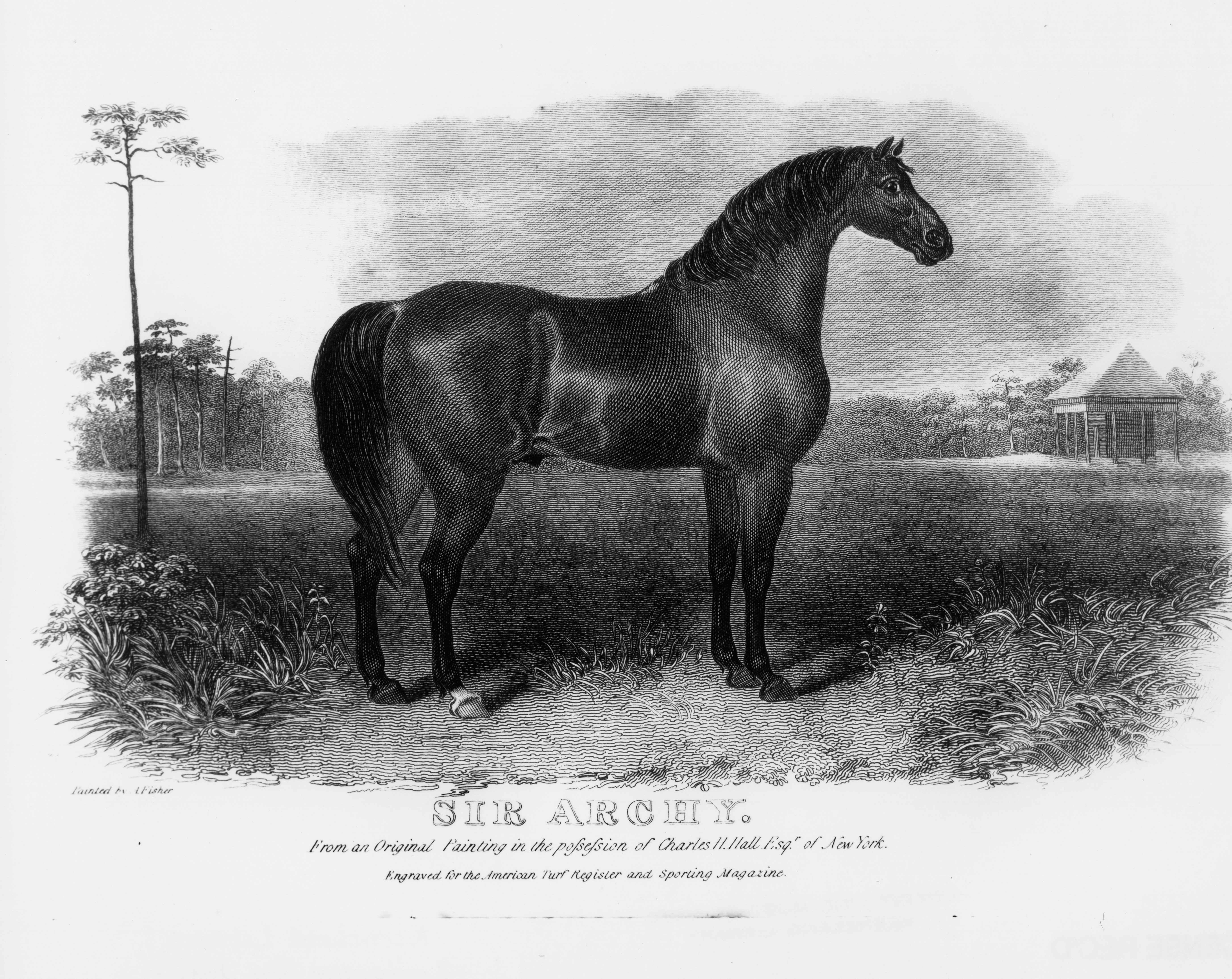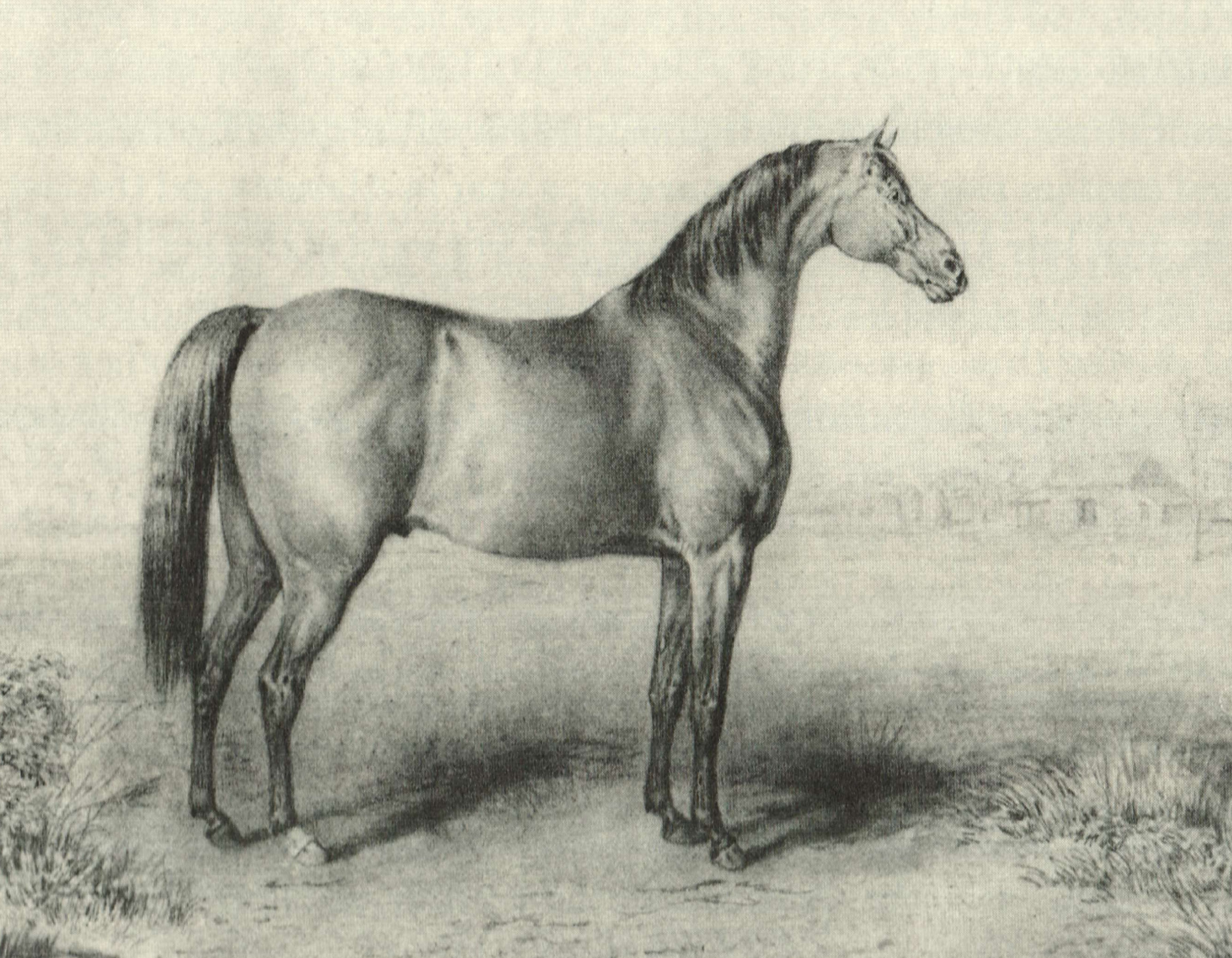Sir Archy (VA)
Sir Archy, America’s first great thoroughbred stallion, was foaled in 1805 at Capt. Archibald Randolph’s Ben Lomond plantation along the James River in Virginia. In the hands of Col. William R. Johnson, Sir Archy became the champion four-mile horse of his day. Upon retirement to stud, he sent out a succession of champions, which essentially established the breed of the American thoroughbred.

1955
1805
Diomed
Castianira
Rockingham
John Tayloe III
Archibald Randolph
Ralph Wormeley VI
William R. Johnson
William R. Davie
Thomas Larkin
Arthur Taylor
1808-1809
$0
Racing Record
8
Starts
| 1808 | 2 | 0 | 0 | 1 | $0 $0 |
| 1809 | 6 | 5 | 1 | 0 | $0 $0 |
Biography
Sir Archy, America’s first great thoroughbred stallion, was foaled in 1805 at Capt. Archibald Randolph’s Ben Lomond plantation along the James River in Virginia. In the hands of Col. William R. Johnson, Sir Archy became the champion four-mile horse of his day. Upon retirement to stud, he sent out a succession of champions, which essentially established the breed of the American thoroughbred.
“He has done as much for the Turf stock of this country as the Godolphin Arabian, King Herod, or Highflyer for that of Great Britain. Most of the best stock at present in this country are either immediately from the loins of Sir Archy or have been produced from his sons and daughters,” commented the American Turf Register in 1829. That comment served as the basis for historians’ repeated references to Sir Archy as the Godolphin Arabian of America.
Sir Archy was described as being “rich bay colour, a horse of commanding size, fully sixteen hands high, with great power and substance,” by the American Turf Register. Heavily patronized during his stud career, nearly 100 of Sir Archy’s sons were advertised as stallions and 160 of his daughters are listed as producers in the American Stud Book. Considering the relatively small number of horses with any claim to the title of blood-horse in the early 1800s, the influence of Sir Archy on the development of the American racehorse is overwhelming.
Sir Archy was originally named Robert Burns by Capt. Randolph, who bred the horse in partnership with Col. John Tayloe III. Capt. Randolph suffered a series of financial losses that forced the sale of his Ben Lomond estate in 1805. Two years later, he sold his half-interest in the colt to Ralph Wormeley VI and in May of 1807 he wrote Col. Tayloe:
“I have sent our fine colt for you to take and do with as you please. I am not able to do him that justice such a horse is entitled to. He is thought to be the best colt that is anywhere, Larkin says the finest two-year-old he ever saw. Mr. Wormeley will inform you what are his engagements; any part of which you may take. I have named him Robert Burns, under which name he is entered.”
When the colt arrived at Tayloe’s Mount Airy, he was promptly renamed Sir Archy in honor of the former master of Ben Lomond and the change was duly noted in the farm stud book.
Sir Archy was sired by Diomed, the first standout English racehorse imported to America. Diomed was undefeated in his first 10 starts, including the 1780 English Derby. Sir Archy’s dam, Castianiri, was imported by Tayloe and turned over to Randolph to breed on shares. Under the agreement, Randolph paid board and training bills on the foals until they reached three. The first foal in the partnership was Sir Archy.
Sir Archy was not an immediate success as a racer. He made his debut in 1808 as a 3-year-old and was distanced in his first start, a race won by Bright Phoebus near Washington, D.C. He was then led down to Richmond, Virginia, and entered against six others in the Fairfield Sweepstakes. Sir Archy finished an exhausted third.
Col. Johnson, who won the race with True Blue, saw something in Sir Archy and offered to purchase him despite the lackluster showing. Johnson offered Wormeley $1,500 and the deal was made. Col. Johnson sent Sir Archy to Warrenton, North Carolina, where he was put in the hands of Arthur Taylor, an Englishman who trained all the good horses Johnson could find.
In the spring of 1809, Sir Archy made his first start as a 4-year-old in the Annual Post Stakes, four-mile heats at Richmond. The day before the Post Stakes, Wrangler had won the Jockey Club Purse in easy fashion and was considered a lock to win the Post Stakes. Sir Archy, however, promptly defeated him with ease.
Sir Archy and Wrangler met again a week later at the Newmarket Course in Petersburg, Virginia. Wrangler won the first heat decisively, but Sir Archy caught him in the second heat and the judges deliberated some time before awarding the decision to Wrangler. Johnson took issue with the decision and proposed a match between Sir Archy and Wrangler that afternoon at four miles. The challenge was turned down and Johnson took his horse back to North Carolina for more training.
That fall, Sir Archy was brought out for the Jockey Club Purse. Four others were entered, including Wrangler. Sir Archy drew off by himself after two miles and had such a long lead that he was pulled up and walked across the finish, leaving all his rivals behind the “distance” pole and eliminating the necessity of running a second heat.
A week later at Petersburg, Sir Archy again distanced his foes and was considered to be in a class by himself. Competition became scarce and Johnson offered to match Sir Archy “against any horse for $5,000 or $10,000, four-mile heats, being satisfied Sir Archy is the best horse I have ever seen.”
Gen. Stephen Carney of North Carolina decided to match his horse Blank against Sir Archy at the Scotland Neck Course near Halifax, North Carolina. Sir Archy won the first heat by a length in 7:52, the fastest four miles ever run south of the James River. He also won the second heat by a length in eight minutes flat.
Among the spectators was Gen. William R. Davie, Revolutionary War hero, governor of North Carolina and founder of the University of North Carolina. He offered $5,000, bought Sir Archy and immediately retired him to stud.
In his first three crops, Sir Archy sired five horses of high distinction: Director, Lady Lightfoot, Vanity, Timoleon, and Reality. These would have been sufficient to establish Sir Archy as a great stallion, but more standout runners kept coming.
Historian John Hervey studied the record of Sir Archy’s progeny at length, trying to pare down the list of Sir Archy’s exceptional sons, and the best he could do was reduce the number to 31, listed in chronological order: Director, Timoleon, Contention, Carolinian, Kosciuski, Napoleon, Virginian, Rattler, Sir Charles (five-time leading sire), Sir William, Childers, Muckle, Sumpter, Sir Henry, John Richards, Stockholder, Arab, Cherokee, Marion, Sir William of Transport, Bertrand, Gohanna, Pacific, Saxe Weimar, Crusader, Sir Archy Montorio, Giles Scroggins, Industry, Tariff, Wild Bill, and Zinganee.
The best of his fillies were Lady Lightfoot, Vanity, Coquette, Reality, Fair Rosamund, Beggar Girl, Farity, Betsey Richards, Duchess of Marlborough, Creeping Cate, Flirtilla, Janet, Isabella, Phillis, Janette, Sally Hope, Kate Kearney, Charlotte Temple, Gabriella, and Virginia Taylor.
Sir Archy died in 1833 at the age of 28.
Media






